Lukas Miklautz
Understanding and Improving Hyperbolic Deep Reinforcement Learning
Dec 16, 2025Abstract:The performance of reinforcement learning (RL) agents depends critically on the quality of the underlying feature representations. Hyperbolic feature spaces are well-suited for this purpose, as they naturally capture hierarchical and relational structure often present in complex RL environments. However, leveraging these spaces commonly faces optimization challenges due to the nonstationarity of RL. In this work, we identify key factors that determine the success and failure of training hyperbolic deep RL agents. By analyzing the gradients of core operations in the Poincaré Ball and Hyperboloid models of hyperbolic geometry, we show that large-norm embeddings destabilize gradient-based training, leading to trust-region violations in proximal policy optimization (PPO). Based on these insights, we introduce Hyper++, a new hyperbolic PPO agent that consists of three components: (i) stable critic training through a categorical value loss instead of regression; (ii) feature regularization guaranteeing bounded norms while avoiding the curse of dimensionality from clipping; and (iii) using a more optimization-friendly formulation of hyperbolic network layers. In experiments on ProcGen, we show that Hyper++ guarantees stable learning, outperforms prior hyperbolic agents, and reduces wall-clock time by approximately 30%. On Atari-5 with Double DQN, Hyper++ strongly outperforms Euclidean and hyperbolic baselines. We release our code at https://github.com/Probabilistic-and-Interactive-ML/hyper-rl .
H-SPLID: HSIC-based Saliency Preserving Latent Information Decomposition
Oct 23, 2025Abstract:We introduce H-SPLID, a novel algorithm for learning salient feature representations through the explicit decomposition of salient and non-salient features into separate spaces. We show that H-SPLID promotes learning low-dimensional, task-relevant features. We prove that the expected prediction deviation under input perturbations is upper-bounded by the dimension of the salient subspace and the Hilbert-Schmidt Independence Criterion (HSIC) between inputs and representations. This establishes a link between robustness and latent representation compression in terms of the dimensionality and information preserved. Empirical evaluations on image classification tasks show that models trained with H-SPLID primarily rely on salient input components, as indicated by reduced sensitivity to perturbations affecting non-salient features, such as image backgrounds. Our code is available at https://github.com/neu-spiral/H-SPLID.
An Introductory Survey to Autoencoder-based Deep Clustering -- Sandboxes for Combining Clustering with Deep Learning
Apr 02, 2025Abstract:Autoencoders offer a general way of learning low-dimensional, non-linear representations from data without labels. This is achieved without making any particular assumptions about the data type or other domain knowledge. The generality and domain agnosticism in combination with their simplicity make autoencoders a perfect sandbox for researching and developing novel (deep) clustering algorithms. Clustering methods group data based on similarity, a task that benefits from the lower-dimensional representation learned by an autoencoder, mitigating the curse of dimensionality. Specifically, the combination of deep learning with clustering, called Deep Clustering, enables to learn a representation tailored to specific clustering tasks, leading to high-quality results. This survey provides an introduction to fundamental autoencoder-based deep clustering algorithms that serve as building blocks for many modern approaches.
Motif Discovery Framework for Psychiatric EEG Data Classification
Jan 08, 2025Abstract:In current medical practice, patients undergoing depression treatment must wait four to six weeks before a clinician can assess medication response due to the delayed noticeable effects of antidepressants. Identification of a treatment response at any earlier stage is of great importance, since it can reduce the emotional and economic burden connected with the treatment. We approach the prediction of a patient response to a treatment as a classification problem, by utilizing the dynamic properties of EEG recordings on the 7th day of the treatment. We present a novel framework that applies motif discovery to extract meaningful features from EEG data distinguishing between depression treatment responders and non-responders. We applied our framework also to classification tasks in other psychiatric EEG datasets, namely to patients with symptoms of schizophrenia, pediatric patients with intractable seizures, and Alzheimer disease and dementia. We achieved high classification precision in all data sets. The results demonstrate that the dynamic properties of the EEGs may support clinicians in decision making both in diagnosis and in the prediction depression treatment response as early as on the 7th day of the treatment. To our best knowledge, our work is the first one using motifs in the depression diagnostics in general.
Plasticity Loss in Deep Reinforcement Learning: A Survey
Nov 07, 2024
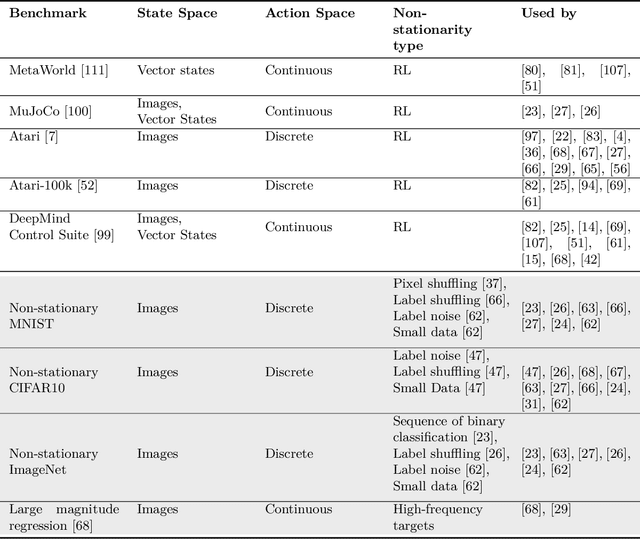
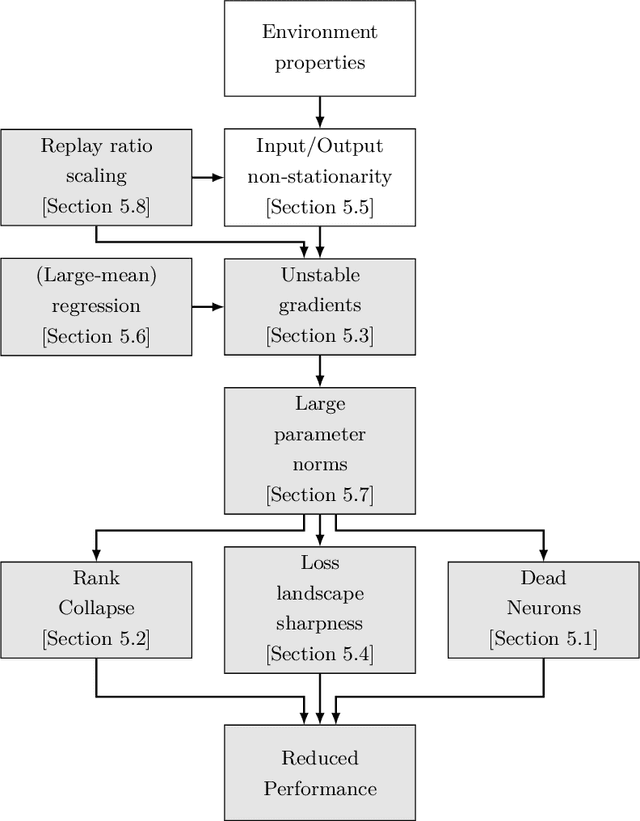
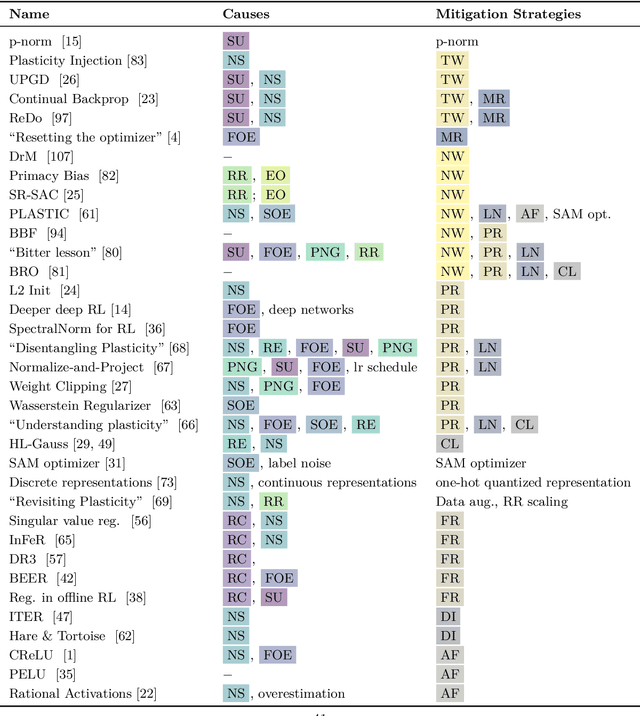
Abstract:Akin to neuroplasticity in human brains, the plasticity of deep neural networks enables their quick adaption to new data. This makes plasticity particularly crucial for deep Reinforcement Learning (RL) agents: Once plasticity is lost, an agent's performance will inevitably plateau because it cannot improve its policy to account for changes in the data distribution, which are a necessary consequence of its learning process. Thus, developing well-performing and sample-efficient agents hinges on their ability to remain plastic during training. Furthermore, the loss of plasticity can be connected to many other issues plaguing deep RL, such as training instabilities, scaling failures, overestimation bias, and insufficient exploration. With this survey, we aim to provide an overview of the emerging research on plasticity loss for academics and practitioners of deep reinforcement learning. First, we propose a unified definition of plasticity loss based on recent works, relate it to definitions from the literature, and discuss metrics for measuring plasticity loss. Then, we categorize and discuss numerous possible causes of plasticity loss before reviewing currently employed mitigation strategies. Our taxonomy is the first systematic overview of the current state of the field. Lastly, we discuss prevalent issues within the literature, such as a necessity for broader evaluation, and provide recommendations for future research, like gaining a better understanding of an agent's neural activity and behavior.
Breaking the Reclustering Barrier in Centroid-based Deep Clustering
Nov 04, 2024



Abstract:This work investigates an important phenomenon in centroid-based deep clustering (DC) algorithms: Performance quickly saturates after a period of rapid early gains. Practitioners commonly address early saturation with periodic reclustering, which we demonstrate to be insufficient to address performance plateaus. We call this phenomenon the "reclustering barrier" and empirically show when the reclustering barrier occurs, what its underlying mechanisms are, and how it is possible to Break the Reclustering Barrier with our algorithm BRB. BRB avoids early over-commitment to initial clusterings and enables continuous adaptation to reinitialized clustering targets while remaining conceptually simple. Applying our algorithm to widely-used centroid-based DC algorithms, we show that (1) BRB consistently improves performance across a wide range of clustering benchmarks, (2) BRB enables training from scratch, and (3) BRB performs competitively against state-of-the-art DC algorithms when combined with a contrastive loss. We release our code and pre-trained models at https://github.com/Probabilistic-and-Interactive-ML/breaking-the-reclustering-barrier .
SHADE: Deep Density-based Clustering
Oct 08, 2024



Abstract:Detecting arbitrarily shaped clusters in high-dimensional noisy data is challenging for current clustering methods. We introduce SHADE (Structure-preserving High-dimensional Analysis with Density-based Exploration), the first deep clustering algorithm that incorporates density-connectivity into its loss function. Similar to existing deep clustering algorithms, SHADE supports high-dimensional and large data sets with the expressive power of a deep autoencoder. In contrast to most existing deep clustering methods that rely on a centroid-based clustering objective, SHADE incorporates a novel loss function that captures density-connectivity. SHADE thereby learns a representation that enhances the separation of density-connected clusters. SHADE detects a stable clustering and noise points fully automatically without any user input. It outperforms existing methods in clustering quality, especially on data that contain non-Gaussian clusters, such as video data. Moreover, the embedded space of SHADE is suitable for visualization and interpretation of the clustering results as the individual shapes of the clusters are preserved.
MIM-Refiner: A Contrastive Learning Boost from Intermediate Pre-Trained Representations
Feb 15, 2024Abstract:We introduce MIM (Masked Image Modeling)-Refiner, a contrastive learning boost for pre-trained MIM models. The motivation behind MIM-Refiner is rooted in the insight that optimal representations within MIM models generally reside in intermediate layers. Accordingly, MIM-Refiner leverages multiple contrastive heads that are connected to diverse intermediate layers. In each head, a modified nearest neighbor objective helps to construct respective semantic clusters. The refinement process is short but effective. Within a few epochs, we refine the features of MIM models from subpar to state-of-the-art, off-the-shelf features. Refining a ViT-H, pre-trained with data2vec 2.0 on ImageNet-1K, achieves new state-of-the-art results in linear probing (84.7%) and low-shot classification among models that are pre-trained on ImageNet-1K. In ImageNet-1K 1-shot classification, MIM-Refiner sets a new state-of-the-art of 64.2%, outperforming larger models that were trained on up to 2000x more data such as DINOv2-g, OpenCLIP-G and MAWS-6.5B. Project page: https://ml-jku.github.io/MIM-Refiner
Text-Guided Image Clustering
Feb 05, 2024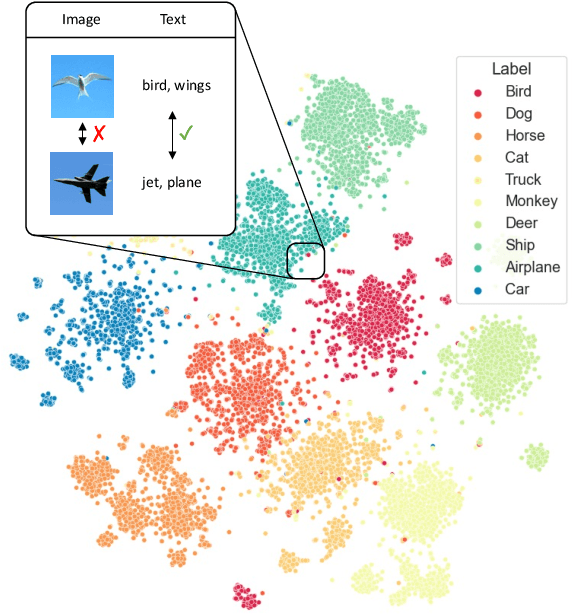

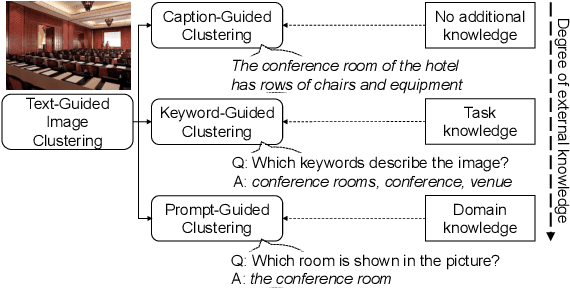

Abstract:Image clustering divides a collection of images into meaningful groups, typically interpreted post-hoc via human-given annotations. Those are usually in the form of text, begging the question of using text as an abstraction for image clustering. Current image clustering methods, however, neglect the use of generated textual descriptions. We, therefore, propose Text-Guided Image Clustering, i.e., generating text using image captioning and visual question-answering (VQA) models and subsequently clustering the generated text. Further, we introduce a novel approach to inject task- or domain knowledge for clustering by prompting VQA models. Across eight diverse image clustering datasets, our results show that the obtained text representations often outperform image features. Additionally, we propose a counting-based cluster explainability method. Our evaluations show that the derived keyword-based explanations describe clusters better than the respective cluster accuracy suggests. Overall, this research challenges traditional approaches and paves the way for a paradigm shift in image clustering, using generated text.
Contrastive Tuning: A Little Help to Make Masked Autoencoders Forget
Apr 20, 2023



Abstract:Masked Image Modeling (MIM) methods, like Masked Autoencoders (MAE), efficiently learn a rich representation of the input. However, for adapting to downstream tasks, they require a sufficient amount of labeled data since their rich features capture not only objects but also less relevant image background. In contrast, Instance Discrimination (ID) methods focus on objects. In this work, we study how to combine the efficiency and scalability of MIM with the ability of ID to perform downstream classification in the absence of large amounts of labeled data. To this end, we introduce Masked Autoencoder Contrastive Tuning (MAE-CT), a sequential approach that applies Nearest Neighbor Contrastive Learning (NNCLR) to a pre-trained MAE. MAE-CT tunes the rich features such that they form semantic clusters of objects without using any labels. Applied to large and huge Vision Transformer (ViT) models, MAE-CT matches or excels previous self-supervised methods trained on ImageNet in linear probing, k-NN and low-shot classification accuracy as well as in unsupervised clustering accuracy. Notably, similar results can be achieved without additional image augmentations. While ID methods generally rely on hand-crafted augmentations to avoid shortcut learning, we find that nearest neighbor lookup is sufficient and that this data-driven augmentation effect improves with model size. MAE-CT is compute efficient. For instance, starting from a MAE pre-trained ViT-L/16, MAE-CT increases the ImageNet 1% low-shot accuracy from 67.7% to 72.6%, linear probing accuracy from 76.0% to 80.2% and k-NN accuracy from 60.6% to 79.1% in just five hours using eight A100 GPUs.
 Add to Chrome
Add to Chrome Add to Firefox
Add to Firefox Add to Edge
Add to Edge